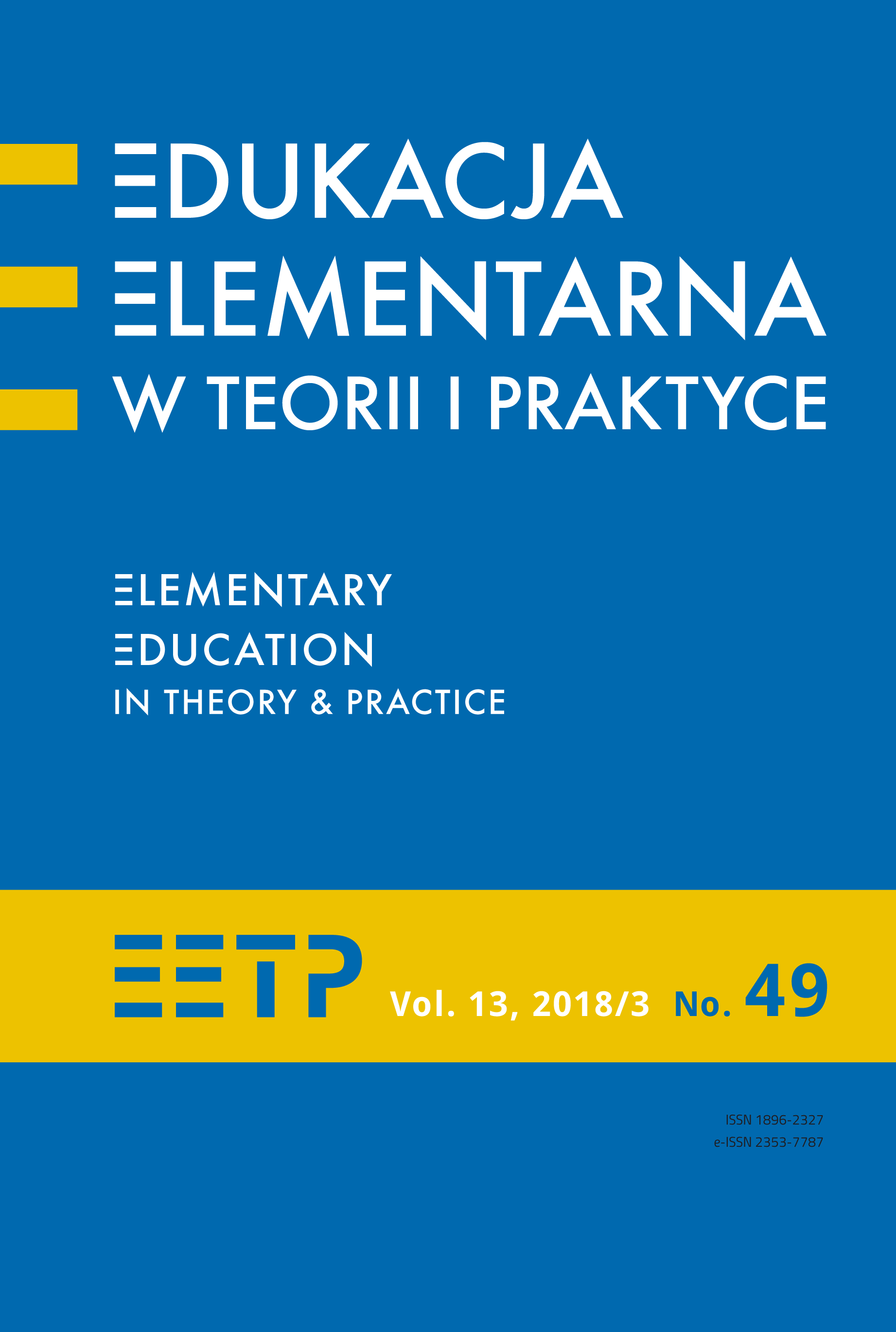Znaczenie zabawki w terapii autyzmu Wybrane aspekty
Abstrakt
Artykuł jest szkicem naukowego namysłu nad zabawką rozumianą jako narzędzie terapeutyczne. Przedmiotem rozważań uczyniłyśmy pracę terapeuty-logopedy z dziećmi autystycznymi w wieku przedszkolnym, koncentrując się na terapii kompetencji społecznych i rozumienia emocji, kształceniu językowym, nauce logicznego myślenia i ćwiczeniu pamięci, a także na aspekcie motywacyjnym zabawki. Celem artykułu jest ukazanie funkcji zabawki w pracy z dzieckiem autystycznym. Należy go traktować jako pewnego rodzaju poradnik na temat możliwości wykorzystania zabawki głównie w gabinecie logopedycznym (bo został napisany z perspektywy logopedów-praktyków), aczkolwiek skierowany jest on do wszystkich osób pracujących z dziećmi – również psychologów, pedagogów, opiekunów i rodziców. Zaproponowane użycia zabawek są stosowane i weryfikowane w terapii opartej na metodzie indywidualnej pracy z dzieckiem zaburzonym, a metodą zbierania materiałów badawczych do artykułu była obserwacja uczestnicząca. Do istotniejszych wniosków z poczynionych obserwacji należą:
- zabawki spełniają ważną rolę w terapii zachowań społecznych, jako że cały proces terapeutyczny zmierza do kształtowania kompetencji - społecznych, a zastosowanie zabawki daje dodatkowo możliwość kontynuowania zabawy poza sytuacją gabinetową;
- zabawka jest doskonałym narzędziem wspomagającym progresję mowy, ułatwia chociażby wprowadzanie i utrwalanie kolejnych kategorii gramatycznych;
- zabawki inspirują wspólne aktywności, co ma znaczenie wysoce terapeutyczne;
- zabawki motywują dziecko do aktywnego udziału w terapii.
Bibliografia
Bobkowicz-Lewartowska L., Autyzm dziecięcy – zagadnienia diagnozy i terapii, Oficyna Wydawnicza „Impuls”, Kraków 2005.
Burton R., Mirski A., Jaka zabawka wspomaga rozwój dziecka, [w:] Stymulująca i terapeutyczna funkcja zabawy, red. M. Kielar-Turska, B. Muchacka, „Agat-print”, Kraków 1999.
Chilińska-Karpowicz E., Jaworska A., Mowa i zabawa. Pedagogika zabawy w pracy logopedycznej, Wydawnictwo Klanza, Lublin 2005.
Cieszyńska J., Nauka czytania krok po kroku. Jak przeciwdziałać dysleksji, wyd. II popr. i poszerz., Wydawnictwo Naukowe Akademii Pedagogicznej, Kraków 2005.
Cieszyńska J., Wczesna diagnoza i terapia zaburzeń autystycznych, Omega Stage System – Jędrzej Cieszyński, Kraków 2011.
Dymara B. (red.), Dziecko w świecie zabawy. O kulturze, cechach i wartościach ludycznej edukacji, Oficyna Wydawnicza „Impuls”, Kraków 2009.
Dymara B. (red.), Dziecko w świecie zabawy. Zabawa i radość w literaturze, muzyce i życiu codziennym, Oficyna Wydawnicza „Impuls”, Kraków 2009.
Dymara B., Zabawa, radość i szczęście w literaturze i życiu dzieci, młodzieży i dorosłych, [w:] Dziecko w świecie zabawy. Zabawa i radość w literaturze, muzyce i życiu codziennym, red. B. Dymara, Oficyna Wydawnicza „Impuls”, Kraków 2009.
Kabacińska K., Od grzechotki do… – słów kilka o zabawkach dziecięcych, „Studia Edukacyjne”, 11, 2010.
Krajewski M., W stronę socjologii przedmiotów, [w:] W cywilizacji konsumpcyjnej, red. M. Golka, Wydawnictwo Naukowe UAM, Poznań 2004.
Kruk-Lasocka J., Autyzm czy nie autyzm. Problemy diagnozy i terapii pedagogicznej małych dzieci, Wydawnictwo Dolnośląskiej Szkoły Wyższej Edukacji, Wrocław 1999.
Kwaśniewska G., Rola i kompetencje w procesie wczesnego wspomagania rodziny dziecka z niepełnosprawnością, [w:] Wczesna diagnoza i wspomagania rozwoju dziecka z dysfunkcjami, red. W. Brejnak, K.J. Zabłocki, Stowarzyszenie Dobra Wola OPP, Warszawa 2009.
Maciejewska-Mroczek E., Mrówcza zabawa. Współczesne zabawki a społeczne konstruowanie dziecka, Universitas, Kraków 2012.
Moroz K., Bliżej edukacji ludycznej – zabawy i zabawki naszych dzieci, [w:] Dziecko w świecie zabawy. O kulturze, cechach i wartościach ludycznej edukacji, red. B. Dymara, Oficyna Wydawnicza „Impuls”, Kraków 2009.
Okoń W., Zabawa a rzeczywistość, wyd. 1, WSiP, Warszawa 1987; wyd. 2, wyd. Żak, Warszawa 1995.
Pisula E., Autyzm. Przyczyny – symptomy – terapia, Wydawnictwo Harmonia, Gdańsk 2010.
Pisula E., Małe dziecko z autyzmem, Gdańskie Wydawnictwo Psychologiczne, Gdańsk 2005.
Przybyła T., Zabawki czy narzędzia edukacyjne? O technologiach informacyjno-komunikacyjnych w rękach współczesnych dzieci, [w:] Zabawka – przedmiot ludyczny i obiekt kolekcjonerski, red. K. Kabacińska-Łuczak, D. Żołądź-Strzelczyk, Poznań 2016.
Tomasello M., Kulturowe źródła ludzkiego poznania, Państwowy Instytut Wydawniczy, Warszawa 2002.
Waloszek D., Zabawa. Edukacja, Ośrodek Doskonalenia Nauczycieli w Zielonej Górze, Zielona Góra 1996.
Winczura B. (red.), Autyzm. Na granicy zrozumienia, Oficyna Wydawnicza „Impuls”, Kraków 2010.
Zmuda E., Kilka uwag o potrzebie wczesnej diagnozy, [w:] Wybrane problemy opieki i edukacji dzieci do trzeciego roku życia, red. I. Kopaczyńska, A. Olczak, Fundacja Edukacja – Demokracja – Rozwój, Zielona Góra 2016.
Żołądź-Strzelczyk D., Gomułka I., Kabacińska-Łuczak K., Nawrot-Borowska M. (red.), Dzieje zabawek dziecięcych na ziemiach polskich do początku XX wieku, Wydawnictwo Chronicon, Wrocław 2016.
Copyright (c) 2018 Edukacja Elementarna w Teorii i Praktyce

Utwór dostępny jest na licencji Creative Commons Uznanie autorstwa – Bez utworów zależnych 4.0 Międzynarodowe.
1. Autor zgłaszając swój artykuł oświadcza, że jest Autorem artykułu (zwanego dalej Utworem) i:
- przysługują mu wyłączne i nieograniczone prawa autorskie do Utworu,
- jest uprawniony/a do rozporządzania prawami autorskimi do Utworu.
Oświadcza, że nie narusza praw autorskich osób trzecich i praw prawnych.
Oświadcza, że nie występuje żaden konflikt interesów.
2. Udziela Uniwersytetowi Ignatianum w Krakowie nieodpłatnej, niewyłącznej, nieograniczonej terytorialnie licencji do korzystania z Utworu na następujących polach eksploatacji:
- utrwalania utworu w formie papierowej, a także na nośniku cyfrowym lub magnetycznym;
- zwielokrotnienia utworu dowolną techniką, bez ograniczenia ilości wydań i liczby egzemplarzy;
- rozpowszechniania utworu i jego zwielokrotnionych egzemplarzy na jakimkolwiek nośniku, w tym wprowadzenia do obrotu, sprzedaży, użyczenia, najmu;
- wprowadzenia utworu do pamięci komputera;
- rozpowszechniania utworu w sieciach informatycznych, w tym w sieci Internet;
- publicznego wykonania, wystawienia, wyświetlenia, odtworzenia oraz nadawania i reemitowania, a także publicznego udostępniania utworu w taki sposób, aby każdy mógł mieć do niego dostęp w miejscu i czasie przez siebie wybranym;
- w zakresie praw zależnych do Utworu, obejmujących w szczególności prawo do dokonania koniecznych zmian w Utworze, wynikających z opracowania redakcyjnego i metodycznego, a także do dokonania tłumaczenia Utworu na języki obce.
Udzielenie licencji następuje z chwilą przekazania Utworu na rzecz Uniwersytetowi Ignatianum w Krakowie. Uniwersytet Ignatianum w Krakowie jest uprawniony do udzielania dalszych sublicencji do Utworu, w zakresie udzielonego prawa. Licencja jest ograniczona czasowo i zostaje udzielona na okres 15 lat, licząc od daty jej udzielenia.
Wyraża się zgodę i zachęca autorów do publikacji ich tekstu w Internecie (np. w repozytorium instytucji lub na jej stronie internetowej) przed lub podczas procesu składania tekstu jako, że może to prowadzić do korzystnych wymian oraz wcześniejszego i większego cytowania opublikowanego tekstu (Patrz The Effect of Open Access). Zalecamy wykorzystanie dowolnego portalu stowarzyszeń badawczych z niżej wymienionych:




